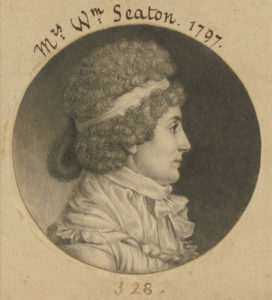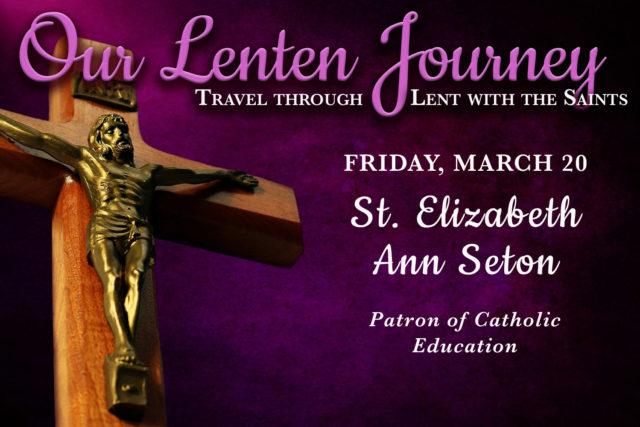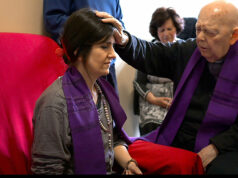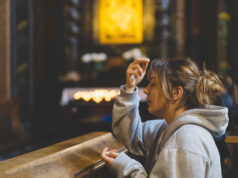With her auspicious beginnings in protestant early America, one would never suspect that Elizabeth Ann Bayley Seton would become the founder of a religious order and a matriarch of Catholic education.
Like Mother Katharine Drexel, Elizabeth was born into a wealthy American family. Her society connections were numerous: Her father, Richard Bayley, was a physician and the first chief health officer of New York City. Her mother, Catherine Charlton, came from one of the first European families that settled in the colonies. Her maternal grandfather was a Church of England priest who served as rector of St. Andrew’s Church on Staten Island for 30 years. After her mother died, her father married Charlotte Barclay, a member of the Roosevelt family.

Born August 28, 1774 as Elizabeth Ann Bayley, Elizabeth was a devout child and avid reader. Her mother died when she was three years old, and she lost a sister the next year. Her father remarried, and her stepmother, Charlotte, took Elizabeth and her older sister, Mary, with her when she did charity work. Elizabeth also spent time with relatives in the country as a child, which deepened her love of God and nature.
When she was 19, Elizabeth married 25-year-old William Seton, a wealthy man who worked in the import business. The newlyweds were the perfect example of a young society couple. The first Episcopal bishop of New York presided at their wedding. They lived on Wall Street. Eventually, they were blessed with five children. But sadness came into their lives: William had always suffered from tuberculosis and his doctor recommended that he travel to Italy for his health. Elizabeth and her oldest daughter accompanied him on the trip. Unfortunately, William died in Italy soon after they arrived and left Elizabeth a widow at age 30.
The seeds of her faith were sown in this, the saddest time of her life. Elizabeth found herself drawn to Catholicism by her association with William’s Italian friends and business partners who had helped her in her time of need and shown her great kindness. She also felt herself drawn to the concept of the Real Presence and felt a great devotion to the Blessed Virgin.
Elizabeth returned to America, and was received into the Catholic faith in 1805. In a time when anti-Catholicism was common, she was rejected by many of her family members because of her conversion. She started an academy for young women, but when the parents of her students discovered that she was Catholic, they withdrew their children from her school.
Her road to the Baltimore area began at her confirmation by Bishop John Carroll of that city, the only Catholic bishop in the United States. Later, Elizabeth met Fr. Louis Dubourg, a visiting Sulpician Father who was associated with St. Mary’s University, and he invited her to come to Emmitsburg, Md., and consider working in education. Elizabeth moved from New York to Maryland, and founded the St. Joseph’s Academy and Free School for Girls. She later went to Philadelphia to found St. Joseph’s Orphan Asylum. Eventually, her deep faith led her to found a religious community, dedicated to caring for the children of the poor, The Sisters of Charity of St. Joseph. From that point on, she was known as Mother Seton. In 1811, the order adopted the Rule of the Sisters of Charity that had been founded by St. Louise de Marillac.
After a life dedicated to caring for family and students, Mother Elizabeth succumbed to complications from tuberculosis on Jan. 4, 1821. She was 46.
Her legacy lives on today in institutions around the country, including the College of St. Elizabeth, Seton Hall University (which was named in her honor by James Roosevelt Bayley) and the Daughters of Charity Health System in New York.
Pope Paul VI canonized Mother on Sept. 14, 1975. She is the first person born in what would become America to be named a saint.
St. Elizabeth Ann Seton’s feast day is Jan. 4
She is the patron saints of Catholic education and orphans.
Learn more about her at the website of her National Shrine: https://setonshrine.org/
She was also inducted into the National Women’s Hall of Fame. Here is her listing at the National Women’s History Museum: https://www.womenshistory.org/education-resources/biographies/elizabeth-ann-seton
The Emmitsburg Area Historical Society has information about Mother Seton: http://www.emmitsburg.net/setonshrine/
Learn more about the Daughters of Charity here: https://daughtersofcharity.org/
Educators: Looking for activities related to Mother Seton and other saints? Check out Teachers Pay Teachers here: https://www.teacherspayteachers.com/Product/Catholic-Saint-Activity-No-Prep-St-Elizabeth-Ann-Seton-4765073







